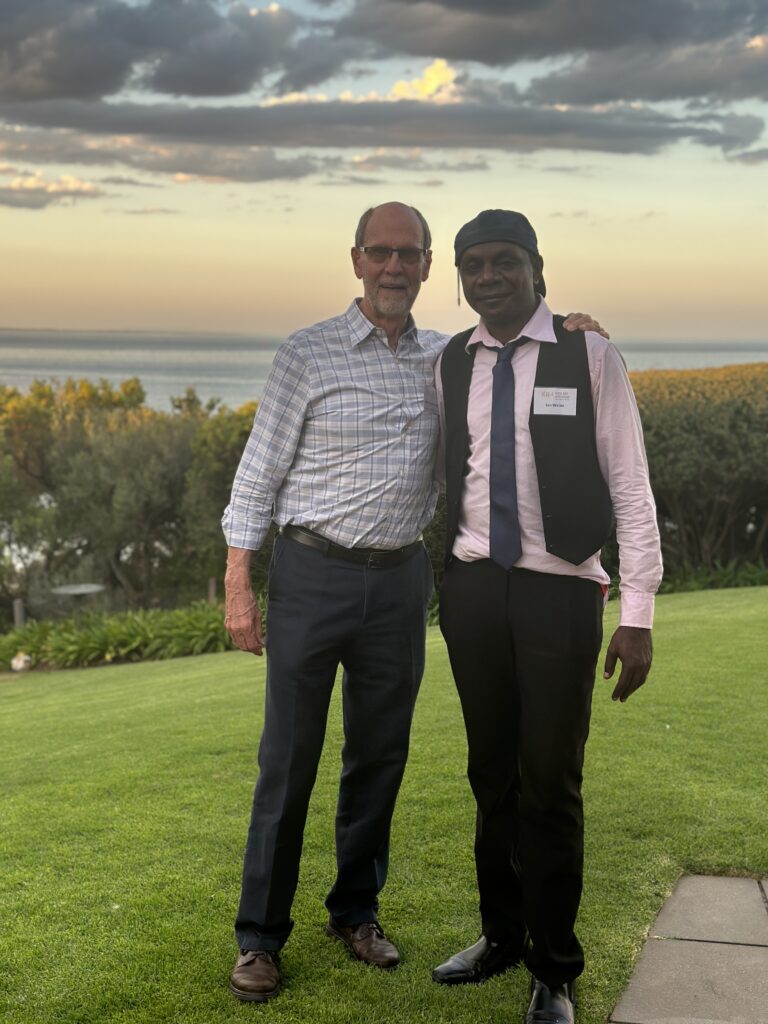ISA2024: Keynotes
‘Two Ways to See’, A Rock Art Research Journey
Biomolecular archaeology: challenging the future
‘Two Ways to See’, A Rock Art Research Journey
Ian Waina and Professor Andy Gleadow AO FAA
Rock art is a significant archive of our rich cultural heritage and helps us understand our Australian history.
Please join Ian Waina and Prof. Andy Gleadow as they share how traditional owners and scientists have worked together over the last decade to determine the age of rock art sites on Kwini and Balanggarra Country in the East Kimberley.
“When I was still at school, I started taking people to visit the rock art sites. The big question the tourists would ask was how old is the rock art? To tell the truth I didn’t know. I would answer them with ‘Its older than me and you’. I really wanted to find the answer to that question.” – Ian Waina.
“We knew from the outset that dating rock was a very hard thing to do because it is mostly not possible to date the pigments and other materials used to make the paintings. Instead, we needed to develop new methods and modify existing ones to find out the age of natural events that happened on the rock surface.” – Prof. Andy Gleadow. This lecture will share personal stories and research findings which reveal the age of Australia’s oldest known painting in a rock shelter.
Ian Waina is a Kwini man from the Kalumburu community in the far north-east corner of the Kimberley. Ian has been part of the research team from the very beginning, trying to understand how long ago the Old people painted the rock art He brings his cultural knowledge which he has learnt from his parents and grandparents and shares it with the research team. Ian believes that bringing cultural knowledge and scientific ways together helps answer some of the questions about the rock art and the history of the Old People. Seeing it both ways: the scientific way and the Aboriginal way. Ian is passionate about finding out more about his Ancestors and what it was like when they painted, their story – preserving the knowledge for future generations.
Andy Gleadow is a geologist, Emeritus Professor and former Head of Earth Sciences at the University of Melbourne. He is a specialist in geological dating, pioneering new techniques for understanding the thermal evolution of the continental crust. He was also involved in the analysis of Moon rocks from the Apollo program and has worked on dating fossil hominin sites in East Africa. His work has been recognised by numerous awards, including the Research Medal of the Royal Society of Victoria, several medals from the Geological Society of Australia, the Jaeger Medal of the Australian Academy of Science, and the International Lazlett Prize for Thermochronology, amongst others. He has been elected a Fellow of the Australian Academy of Science, the American Geophysical Union, the Geochemistry Society and the European Association of Geochemistry. He was made an Officer in the Order of Australia (AO) for distinguished service to the earth sciences and education in 2017.

Biomolecular archaeology: challenging the future
Associate Professor Ester Oras
Biomolecular methods have been part of archaeological research since the mid-20th century. However, recent decades have witnessed an exponential growth of natural science applications for studying ancient past, and for many the incorporation of isotopes, lipids, proteins and aDNA has become the bread and butter of archaeological studies. In this talk I will outline the roots of biomolecular archaeology mapping the main strands and crucial turning points leading to the current state-of-the-art. I will explore the tensions and challenges, but also highlight some good examples of bridging the humanities and natural sciences in archaeology. Finally, I would like to suggest some future perspectives for more integrated, cohesive, equitable and synergetic biomolecular archaeology, to better sustain its transdisciplinary research agenda for understanding the past and explaining it to our contemporary world.
Ester Oras is an associate professor in analytical chemistry and archaeology, and the director of Archemy lab at the University of Tartu, Estonia. She obtained her PhD degree in archaeology from the University of Cambridge in 2014, and has dedicated her career to bridging the humanities and natural sciences ever since. She is the first specialised archaeochemist in the eastern Baltics, who introduced the field of organic residue analysis to the region. Her main field of research is the use of biomolecular archaeology (lipids, proteins, isotopes) to study ancient diet, diseases and migrations, with a specialisation in pre- and protohistory of the Baltic Sea region.
